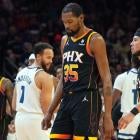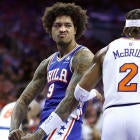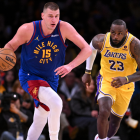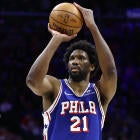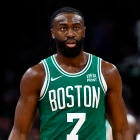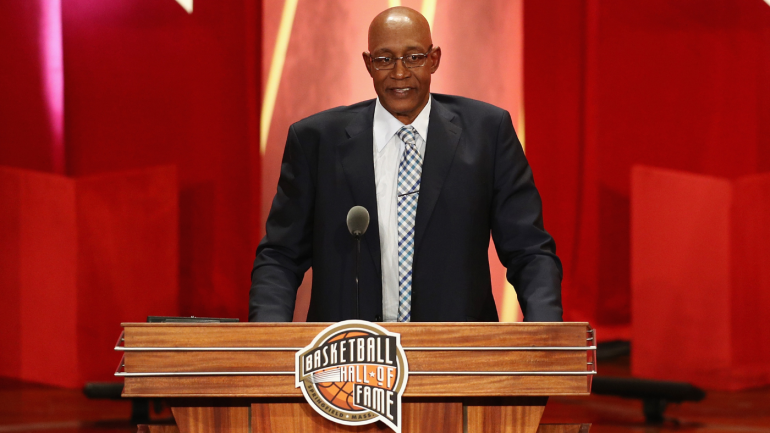
George McGinnis, who starred for the Indiana Pacers, Philadelphia 76ers and Denver Nuggets in the 1970s and was inducted into the Naismith Memorial Basketball Hall of Fame in 2017, died Thursday morning at the age of 73.
McGinnis suffered a cardiac arrest at his home last week and was taken to Community North Hospital in Indianapolis, where, according to the Pacers, "family, friends and former teammates maintained a vigil of support until his passing."
Born in Indianapolis in 1950, McGinnis was named Mr. Basketball USA (and Indiana Mr. Basketball) in 1969, having led Indianapolis Washington High School to a 31-0 record and a state title. He played one season at Indiana University, where he led the Big Ten in scoring and rebounding. This September, he was inducted into the Indiana University Hall of Fame.
McGinnis found immediate success as a pro, winning an ABA championship with his hometown Pacers as a rookie and making the first of his six career All-Star appearances (three ABA, three NBA) in 1972-73, his second season. Indiana repeated as champions, with McGinnis scoring 27.6 points per game in the regular season and earning All-ABA Second Team and Playoffs MVP honors.
"When I came into the ABA, I was like a god," McGinnis once said. "I felt there was no one who was ever going to stop me, that I was going to be a dominant force every time I took the court. That's how supreme I felt and that's how supreme I played."
In 1973-74 and 1974-75, McGinnis made the All-ABA First Team. He averaged a career-high (and league-high) 29.8 points, a career-high 6.3 assists and 14.3 rebounds in 1974-75 and, along, with Julius Erving, was named co-MVP. In 1975, he became the first player in ABA/NBA history to record a 50-point triple-double in the playoffs, with a 51-point, 17-rebound, 10-assist performance against the San Antonio Spurs.
"McGinnis is so strong you'd swear he weighs 300 pounds," former Virginia Squires forward Willie Wise told Sports Illustrated in 1975. "When he posts inside on you, there's nothing you can do. He's going to the basket."
That same Sports Illustrated story noted that McGinnis had dunked so hard in Denver that the rim needed to be replaced and had gone through two dozen pairs of shoes in his final ABA season because he ran with such force that the seams kept bursting.
"Rims bend, bones break," McGinnis said after doing that damage in Denver, shrugging off the third broken rim of his career, per Sports Illustrated.
In 1975-76, McGinnis' first year in the NBA, he was named to the All-NBA First Team as a member of the 76ers. He made the All-NBA Second Team the following season and, along with Erving and Doug Collins, led the Sixers to the NBA Finals, where they lost to the Portland Trail Blazers.
George McGinnis was a Hall of Famer on and off the court, earning several accolades during an ABA-NBA career that spanned a decade.
— Philadelphia 76ers (@sixers) December 14, 2023
He joined our team in the mid-70s and proved to be an incredible force alongside Julius Erving - the duo leading our team to a 1977 NBA Finals… pic.twitter.com/EtGGJY8Vwx
McGinnis made his final All-Star appearance in 1979 as a member of the Nuggets, who acquired him in a trade involving Bobby Jones. Indiana reacquired McGinnis in 1980, trading a young Alex English to Denver, and McGinnis retired a Pacer in 1982, after an 11-year career. McGinnis is one of four Pacers to have his jersey (No. 30) retired. (Reggie Miller, Mel Daniels and Roger Brown, all Hall of Famers, are the others.)
"He was obviously a great player in the ABA and the NBA," Indiana coach Rick Carlisle said Wednesday. "There weren't a lot of guys that crossed over to being ABA All-Stars and NBA All-Stars, and I believe he was one of the few."
McGinnis was in fact one of only 20 players to be named an All-Star in both leagues, and one of only nine to make multiple All-Star appearances in both leagues. Erving, George Gervin, Rick Barry and Artis Gilmore are the only other players to have made three ABA All-Star teams and three NBA All-Star teams.
"From his all-state high school days to his time as an IU All-American and, of course, to his legendary ABA championship runs with the Pacers, George McGinnis shaped so many of the fondest basketball memories for generations of Hoosiers," the Simon family and Pacers Sports & Entertainment wrote in a statement. "He was the very definition of an Indiana basketball legend, a champion, and Hall of Fame athlete. But he was more than that. George was family. A passionate advocate for his fellow ABA players and a present, smiling face around the franchise, George has been as synonymous with our Pacers franchise as anyone. He will be greatly missed, and all of us at Pacers Sports & Entertainment will keep George and his family in our prayers."
Carlisle described McGinnis as "beyond legendary in the world of the Pacers" and a "wonderful man," adding that McGinnis was one of the reasons that Philadelphia was his favorite team for a time in high school.
"He was the ultimate combination of brute physical strength and amazing skill," Carlisle said. "He had hands that were probably as big... as I've ever seen a player have. I know Julius Erving has big hands, too, but George used to take the ball off the dribble in one hand and put it up and just shoot it, and it was extremely unique. It was one of the signature things that he did."
"Until LeBron [James] came along, I never saw another guy that had George's physical abilities on a basketball court," Erving once said. Erving also said McGinnis was "built like Superman."
McGinnis, also an All-American football player in high school, was difficult to emulate because of his physical gifts. While Carlisle described himself as "heartbroken" by Philadelphia's defeat in the 1977 Finals, he was not out on the playground taking one-handed double-pump shots, McGinnis-style.
"Nobody has hands that big," Carlisle said. "How do you try to copy it? Unless you're doing it with a nerf ball at home. That's how I did it. And I have big hands. But he was a very, very distinctive player."
Carlisle said that his wife, Donna Nobile, had hosted a get-together for Pacers significant others on Tuesday, during which the 91-year-old Nancy Leonard -- a former Pacers assistant general manager and the wife of the late Hall of Fame coach Bobby "Slick" Leonard -- "gave a very passionate tribute" to McGinnis.
"We see his name every day in the practice facility, it's up on a banner," Carlisle said. "We see it at Gainbridge [Fieldhouse], it's up in the rafters: 'George McGinnis, Hall of Fame.' And so our hearts are heavy right now and we wish the best for the family."
During his Hall of Fame induction speech in 2017, McGinnis said that his story begins with his parents, Burnie and Willie McGinnis, moving to Indiana from Harpersville, Alabama. "That turned out to be one of the best things that ever happened to me because it's hard growing up in Indiana and not falling in love with the game of basketball," he said. At 6 years old in 1956, his life changed forever when, on his family's first television, he watched Oscar Robertson lead Crispus Attucks High School to its second state championship.
"The next day was a Sunday, and it seemed as though every boy in our neighborhood was out shooting buckets," McGinnis said. "We all wanted to be like The Big O."
The previous year, Crispus Attucks High had become the first all-Black school in the United States to win a state title; this time, it was the first team to go undefeated and win the Indiana state title. Thirteen years later, McGinnis broke Robertson's state records for scoring and rebounding as Indianapolis Washington High became the second team to win the Indiana state title without a loss.
In 2000, McGinnis told Sports Illustrated that he was "too awestruck to talk" when, as a high school senior, he met Robertson. He also said that he was moved to tears the first time he watched "Hoosiers."
"One of the great things about being in Indiana is that if you have any level of basketball success here, the people never forget you," McGinnis said.















